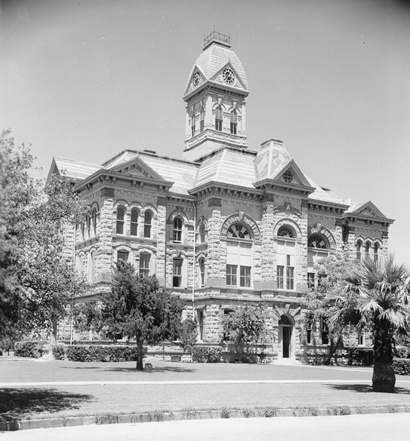|
|
This
is not a tree that Joyce Kilmer would've praised - it's not one that
the village blacksmith would seek the shade of. It hanged no one -
even in effigy. In fact it looks as if it was the nearest tree to
a chainsaw demonstration booth at a lumberjack's convention.
Why is it historic? Politics. Why do we write about it? Because like
a childhood pet (or a younger sibling) it's so ugly it's cute.
The Bryan Courthouse Cedar is a fine example of arboreal tenacity.
Its longevity however is directly tied to its location. If it didn't
grow directly in front of the courthouse it would've been a fence
post long ago. It has outlived four
courthouses so far and we hope it will outlive the one it currently
shares space with. |
|
|
The
Brazos Courthouse Cedar, September 2001
TE photo |
Our
story finally begins:
In 1841 when Navasota County (later to become Brazos
County) was created, the tiny tree was growing alongside the cabin
of Joseph Ferguson, near the Navasota River. This cabin served
as the first county courthouse since it was there that the first court
convened and where county officials were first elected.
The Ferguson cabin didn't have a floor plan amenable to such a crush
of politicians. Many went home imprinted by the belt buckles of their
political colleagues. So a new courthouse was planned for a new county
seat of government - in Boonville.
Politicians were measured and the cabin was built to accommodate their
collective girth.
The little cedar missed out on this courthouse and in juvenile
bliss added a few growth rings to its trunk back at the Ferguson cabin.
The Texas Congress in 1842 changed the county name from
Navasota to Brazos - just to make things difficult for
geography teachers.
A frame courthouse was built in 1846 (also in Boonville)
and in 1854 we get back to the story of our featured tree.
Since the 1846 building had been used from everything from dances
to hog-scaldings, they added a second story when they built the new
one.
Enter Colonel Harvey Mitchell. The Colonel was called "The
Father of Brazos County" by almost everyone. (Except for his children
who simply called him Daddy.) The Colonel took it upon himself to
have trees and shrubs planted around the new courthouse and went so
far as to include the little fellow from the Ferguson cabin who was
still in saplinghood.
When Bryan
superseded Boonville
as county seat in 1866 the tree stayed where it was - gathering
strength for future transplanting.
1870 saw Brazos
County erecting it's fourth courthouse - on the site where today's
current (6th) courthouse stands. Colonel Mitchell had the cedar transplanted
again. After 20-some years - the fourth courthouse started showing
it's age and civil servants started disappearing from their second
story offices. It was found that they were "slipping through the cracks"
- literally.
In the early 1890s - they took bids on a new courthouse (the
5th) and an architect named Eugene
Heiner won the commission. Heiner designed many Texas Courthouses,
although the only one extant is in Hallettsville.
|
 |
Plaque
for the Brazos County courthouse cedar.
It reads:
This tree has stood at three Brazos County courthouses.
1841 Ferguson Springs, 1843 Boonville,
1892 Bryan.
William Scott Chapter, D.A.R.,
Bryan
- 1932. |
There
is a custom of turning historic trees into gavels upon their death.
The inherent brittleness of cedar would prevent this tree from being
used for that purpose, but it is entirely possible (especially considering
the practicality of Texans) that upon retiring, some future Brazos
County Judge might receive a real nice varnished fence post with a
small brass plaque.
© John
Troesser
September 2001 feature |
| Texas
Escapes, in its purpose to preserve historic, endangered and vanishing
Texas, asks that anyone wishing to share their local history, stories,
landmarks and recent or vintage photos, please contact
us. |
|
|
